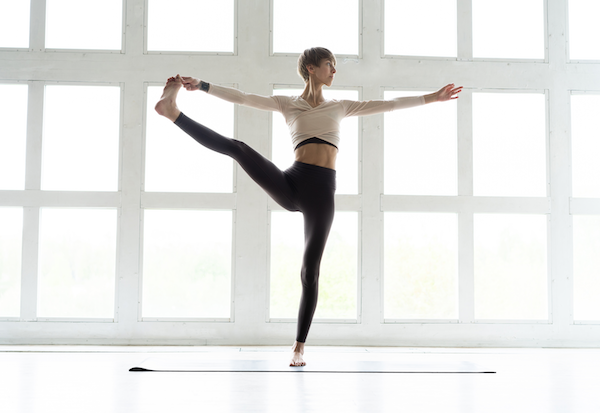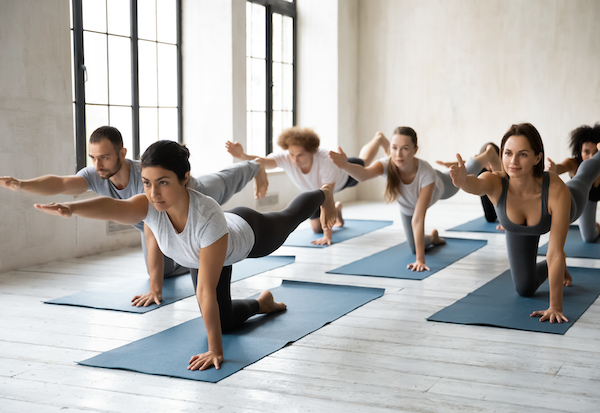
Are you looking to deepen your yoga practice and try out new challenging poses? The Dancing Shiva yoga pose is a beautiful and dynamic posture that will test your balance, flexibility, and strength.
Let’s dive into it!
Table of Contents
Dancing Shiva Yoga Pose Information
- Common name: Dancing Shiva
- English name: Dancing Shiva
- Sanskrit name: Parivrtta Hasta Padangusthasana
- Level: Intermediate/Advanced
- Position: Standing balance pose
- Chakras involved: Manipura (Solar Plexus), Anahata (Heart)
- Stretches: Quadriceps, hip flexors, chest, shoulders
- Strengthens: Legs, core muscles, back muscles
Anatomy of the Dancing Shiva Yoga Pose
When practicing the Dancing Shiva Yoga Pose, also known as Parivrtta Hasta Padangusthasana, it’s important to understand the anatomy of the pose. This will help you to perform the pose correctly and avoid injuries.
Firstly, it’s important to note that this pose is named after the Hindu god Shiva Nataraja, the Lord of Dance, who embodies the rhythm and harmony of the universe. As you perform the pose, you can imagine channeling Shiva’s energy and embodying his qualities of strength, balance, and transformation.
Now, let’s take a look at the anatomy of the pose. The Dancing Shiva yoga Pose is a deep twist that requires balance, flexibility, and strength. Here are the key anatomical areas involved in the pose:
- Legs: The pose involves balancing on one leg while extending the other leg parallel to the floor. This requires strength in the standing leg and flexibility in the extended leg.
- Hips: The pose requires a deep twist, which involves rotating the hips. This requires flexibility in the hip joints and muscles.
- Abdominals: The pose requires engaging the core muscles to maintain balance and stability.
- Spine: The pose involves a deep twist in the spine, which requires flexibility in the spinal muscles and joints.
- Shoulders and Arms: The pose requires reaching the extended leg with the opposite hand, which requires flexibility in the shoulders and arms.
As you perform the Dancing Shiva yoga pose, focus on engaging these key areas of the body and maintaining proper alignment. Remember to breathe deeply and listen to your body, making adjustments as needed to avoid discomfort or injury.
Overall, understanding the anatomy of the Dancing Shiva yoga pose can help you to perform the pose correctly and safely, while also channeling the energy and qualities of Shiva.
Step-by-Step Instructions
To perform the Dancing Shiva yoga pose, also known as Parivrtta Hasta Padangusthasana, follow these steps:
- Begin by standing in Mountain Pose or Tadasana with your feet hip-width apart and your arms by your sides.
- Inhale and lift your right knee towards your chest, holding onto your right big toe with your right hand.
- Exhale and extend your right leg forward, straightening it as much as possible.
- Inhale and reach your left arm up towards the ceiling.
- Exhale and twist your torso to the right, bringing your left elbow to the outside of your right knee.
- Hold the pose for a few breaths, then release and repeat on the other side.
Make sure to keep the following in mind when performing this posture:
- Keep your gaze focused on a single point to help maintain your balance.
- Engage your core muscles to help stabilize your body.
- If you’re having difficulty reaching your big toe, you can use a strap or towel to help you extend your leg forward.
The Dancing Shiva yoga pose is a challenging posture that requires balance, strength, and flexibility. It is a variation of the Dancer Pose or King Dancer Pose, which is also known as Natarajasana in Sanskrit. This pose is often referred to as the “Ring of Fire” due to the intense stretch it provides to the legs and hips.
By practicing this pose regularly, you can improve your balance, strengthen your legs and core, and increase your flexibility. It is a great pose to incorporate into your yoga practice if you’re looking to challenge yourself and take your practice to the next level.
Beginner’s Tips
If you’re new to the Dancing Shiva pose or Parivrtta Hasta Padangusthasana, don’t worry! This pose can be challenging, but with the right mindset and approach, you can master it in no time. Here are some beginner’s tips to help you get started:
Warm up before you begin
It’s important to warm up your body before attempting any yoga pose, especially a challenging one like Dancing Shiva. Start with some gentle stretches to loosen up your muscles and prepare your body for the pose.
Use props if needed
If you’re having trouble balancing or reaching your foot, don’t be afraid to use props. A strap can help you create more space and reach your foot more easily. You can also use a wall for extra support or keep your backhand on your hip for added stability.
Focus on your breath
As you move into the pose, focus on your breath. Take deep, slow breaths to help you stay calm and centered. This will also help you maintain your balance and hold the pose for longer.
Keep your gaze forward
Keeping your gaze forward or to the side can help with balance and prevent dizziness. Avoid looking down at your foot or up at the ceiling.
Don’t force the pose
Remember, yoga is not a competition. Don’t force the pose or push yourself beyond your limits. Listen to your body and only go as far as feels comfortable for you.
By following these beginner’s tips, you’ll be well on your way to mastering the Dancing Shiva pose. Remember to be patient with yourself and enjoy the journey!
Dancing Shiva Yoga Pose Sequences
If you want to practice the Dancing Shiva yoga pose, you can include it in your yoga sequence. Here are some yoga sequences that you can follow to prepare your body for the pose:
Preparatory Poses
Before you start, you need to warm up your body with some preparatory poses. These poses will help you stretch your muscles and improve your balance. Here are some preparatory poses that you can include in your yoga sequence:
- Tree pose
- Chair pose
- Low lunge
Yoga Sequence
Once you have warmed up your body with preparatory poses, you can include Dancing Shiva pose in your yoga sequence. Here is a yoga sequence that you can follow:
- Start with Mountain pose
- Move into Chair pose
- Transition into Low lunge
- Move into Warrior II pose
- Transition into the Triangle pose
- Move into Half Moon pose
- Transition into the Dancing Shiva pose
- End with Corpse pose
You can repeat this sequence as many times as you want. Remember to breathe deeply and hold each pose for a few breaths before transitioning into the next pose.
Tips
Here are some tips that can help you practice the Dancing Shiva pose:
- Focus on your breath and try to maintain your balance
- Keep your core engaged and your gaze steady
- Use a block or a wall for support if needed
- Practice regularly to improve your balance and flexibility
By following these yoga sequences and tips, you can prepare your body for the Dancing Shiva pose and improve your overall yoga practice.
Dancing Shiva Yoga Pose Benefits
If you’re looking for a yoga pose that can help you improve your balance, focus, and concentration, then look no further than Dancing Shiva yoga pose. This pose, also known as Parivrtta Hasta Padangusthasana, is a standing balance pose that requires strength, flexibility, and mental focus.
Calm your mind and improve your mental focus
As you balance on one leg and twist your torso, you’ll need to stay present and focused to maintain your balance. This can help you cultivate a sense of mindfulness and presence that can carry over into other areas of your life.
Strengthen and tone your legs and core
As you balance on one leg, you’ll need to engage your leg muscles to maintain your stability. This can help you build strength and endurance in your legs and core, which can improve your overall fitness and health.
Improve your balance and coordination
By practicing this pose regularly, you can train your body to maintain its balance and stability even in challenging situations. This can help you feel more confident and secure in your movements, both on and off the yoga mat.
Improve your spinal flexibility and open up your hips
As you twist your torso and reach for your extended foot, you’ll stretch and lengthen your spine. This can help improve your posture and reduce tension and pain in your back. Additionally, the pose can help open up your hips, which can improve your overall mobility and flexibility.
Overall, the Dancing Shiva Pose is a challenging and rewarding yoga pose that can help you improve your physical and mental fitness. With regular practice, you can cultivate greater balance, focus, and strength, both on and off the mat.
Advanced Variations and Modifications
If you’re an advanced yogi looking to take your Dancing Shiva Pose to the next level, there are several modifications and variations you can try. These variations will challenge your balance, strength, and flexibility while deepening your practice. Here are some advanced variations and modifications you can try.
Wall Variation
If you’re struggling to balance in the pose, try using a wall for support. Stand with your back against the wall and place your extended leg against the wall. Use the wall to help you balance and hold the pose for a few breaths before switching sides.
Strap Modification
For a deeper stretch in the hamstrings, try using a strap. Wrap the strap around your extended foot and hold onto the ends with your opposite hand. Use the strap to gently pull your foot towards your head while maintaining your balance in the pose.
Challenge Variation
To challenge your balance and strength, try transitioning from Dancing Shiva Pose to Half Moon Pose. From Dancing Shiva Pose, slowly begin to straighten your standing leg and shift your weight onto your extended leg. Reach your opposite hand towards the ground and lift your other arm towards the sky. Hold the pose for a few breaths before transitioning back to Dancing Shiva Pose.
Drishti Focus
To improve your focus and concentration in the pose, try changing your drishti (gaze). Instead of looking straight ahead, try looking up toward your extended hand or down toward your standing foot. This will challenge your balance and help you stay present in the pose.
Openness Variation
To open up your hips and chest even further, try adding a backbend to the pose. From Dancing Shiva Pose, begin to arch your back and lift your chest towards the sky. Reach your extended arm towards the sky and hold the pose for a few breaths before transitioning back to the original pose.
Remember to always listen to your body and only attempt advanced variations when you feel comfortable and confident in the pose. With practice and patience, you’ll be able to deepen your Dancing Shiva Pose and take your yoga practice to new heights.
Conclusion
Congratulations on completing your Dancing Shiva Pose practice! Remember that this pose requires patience, focus, and stability. It may take some time to find your sense of balance, so be kind to yourself as you explore this posture.
If you are interested in discovering more poses for your practice, you may want to take a look into other articles where we covered:
Namaste!



